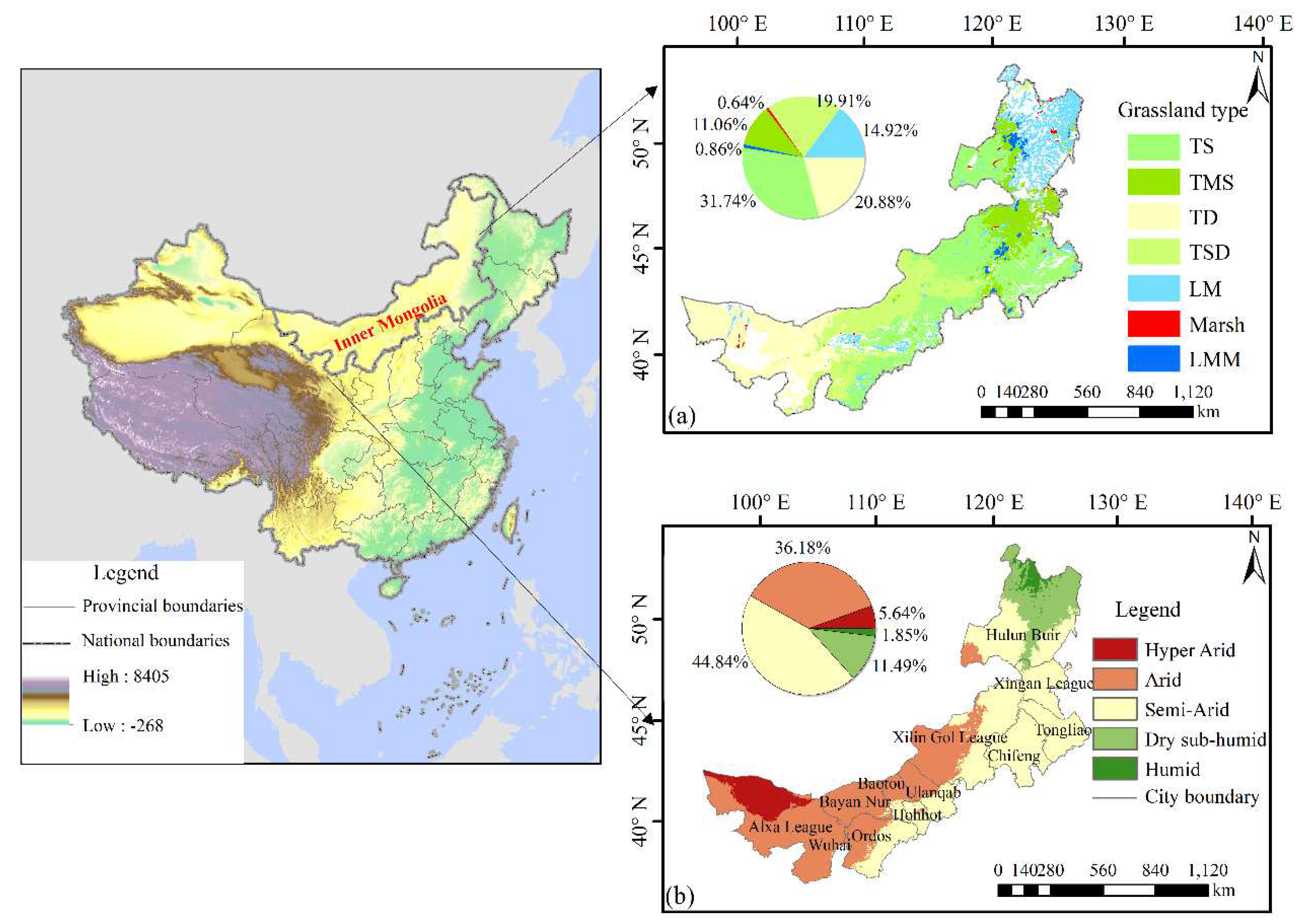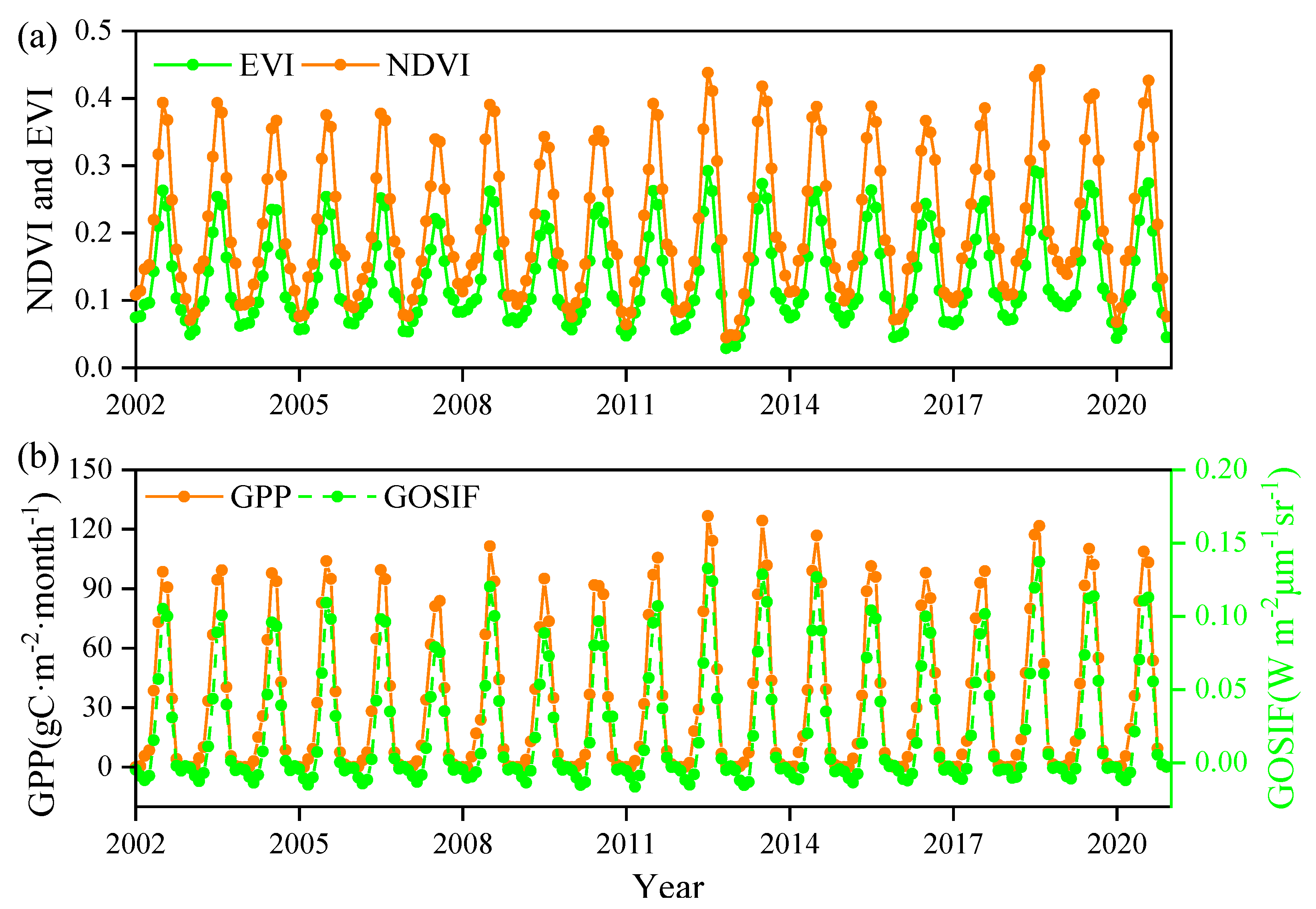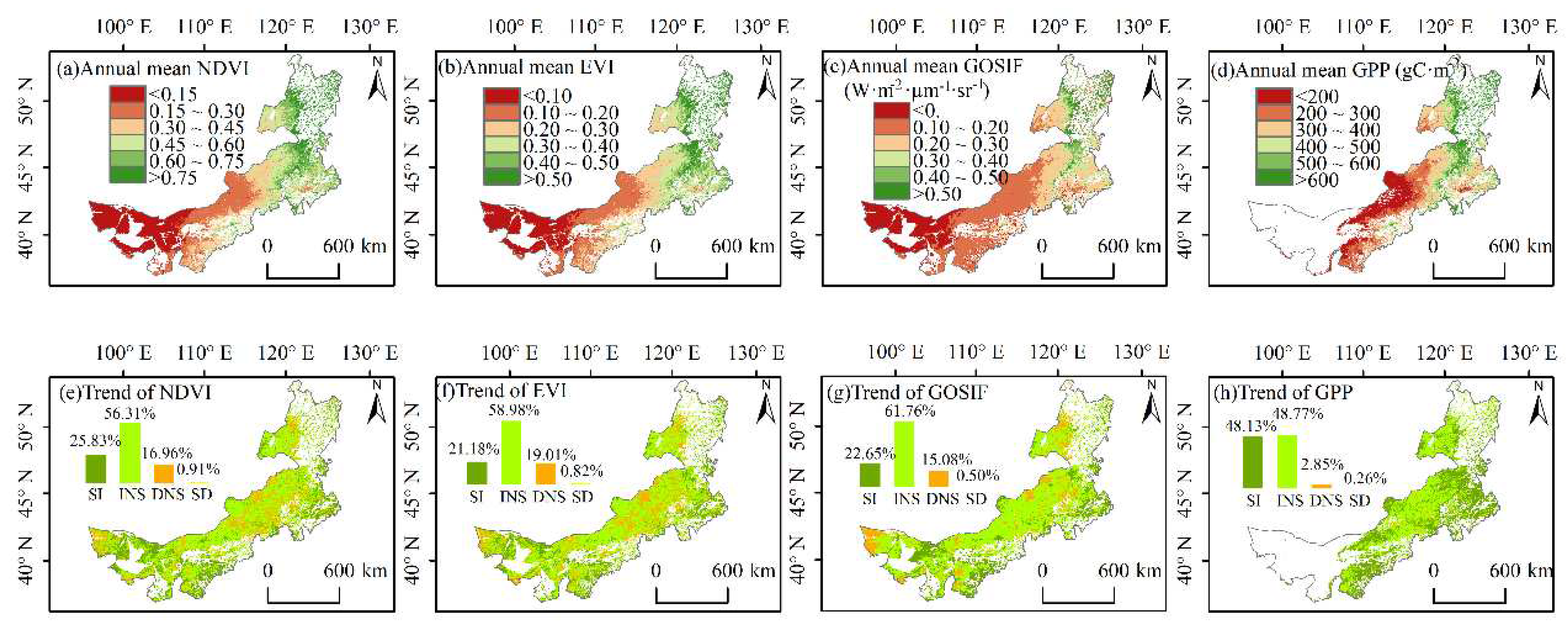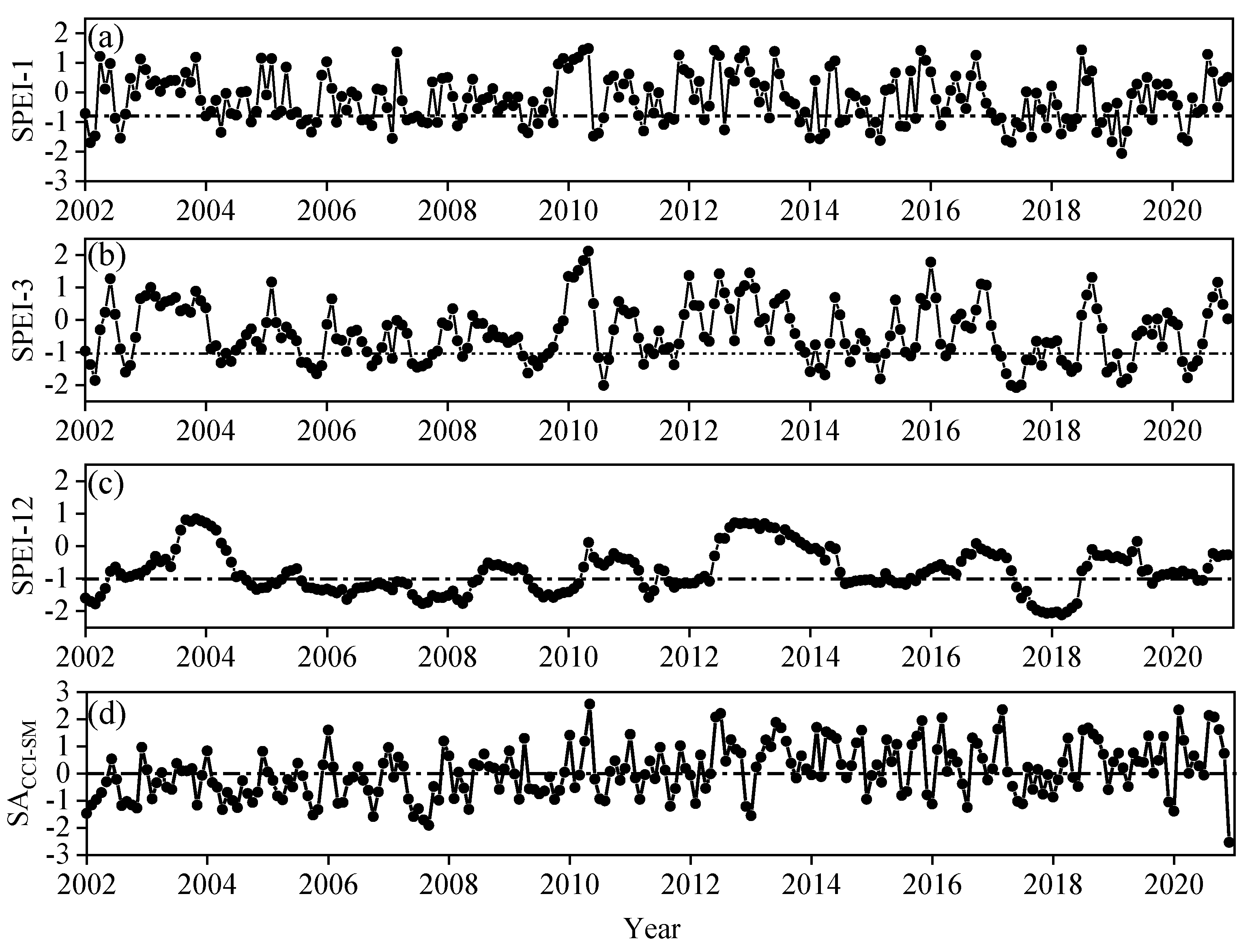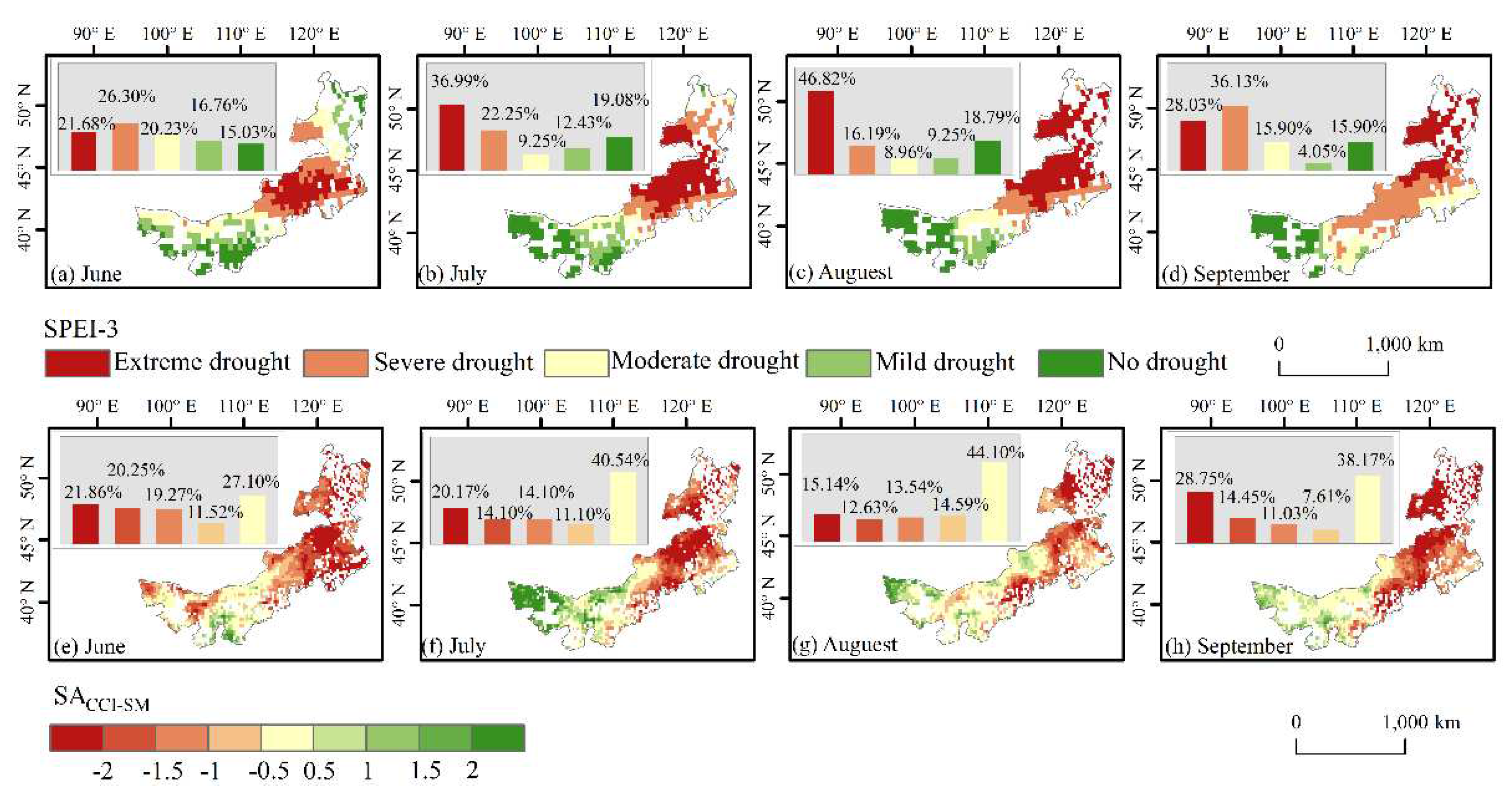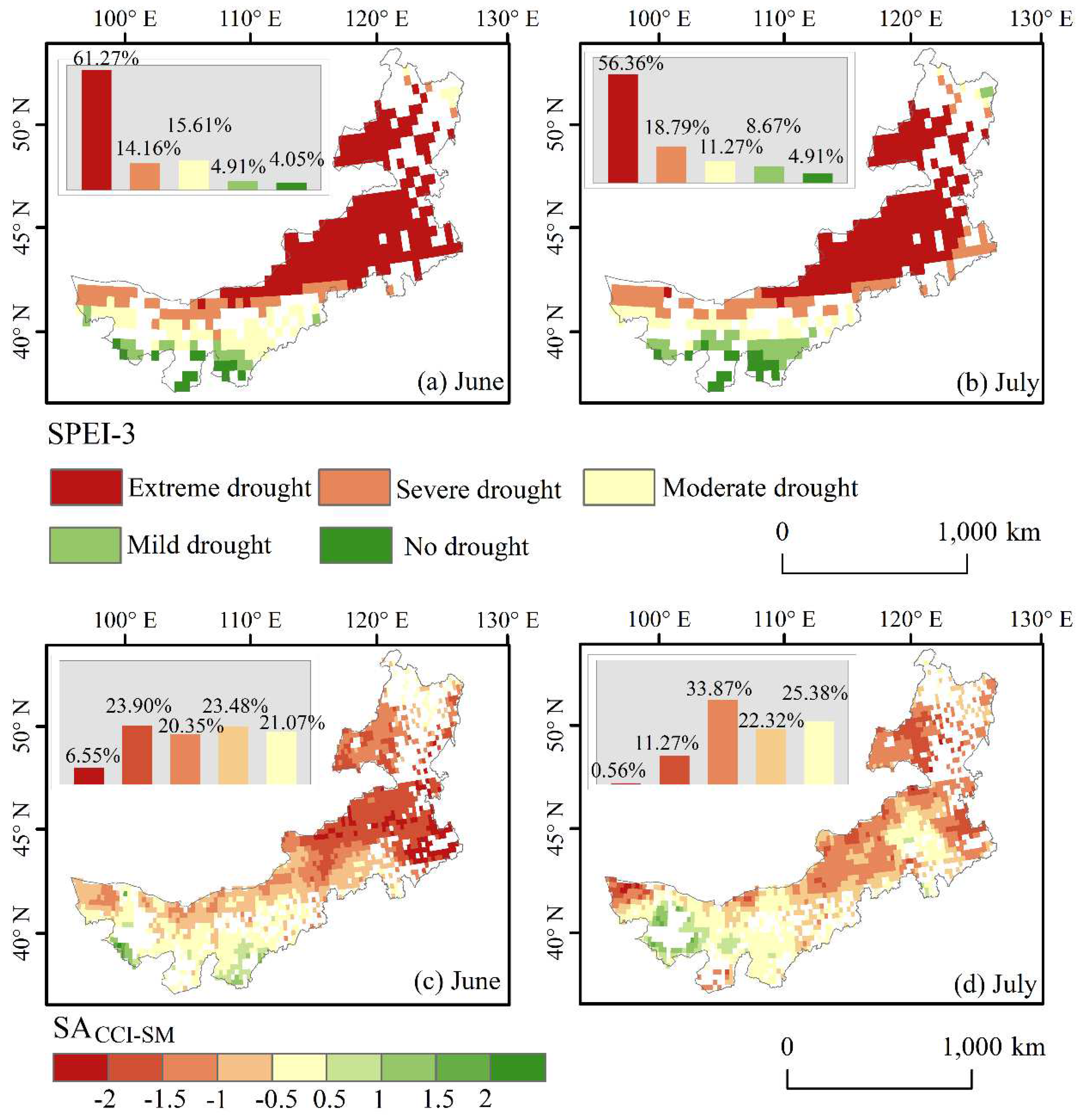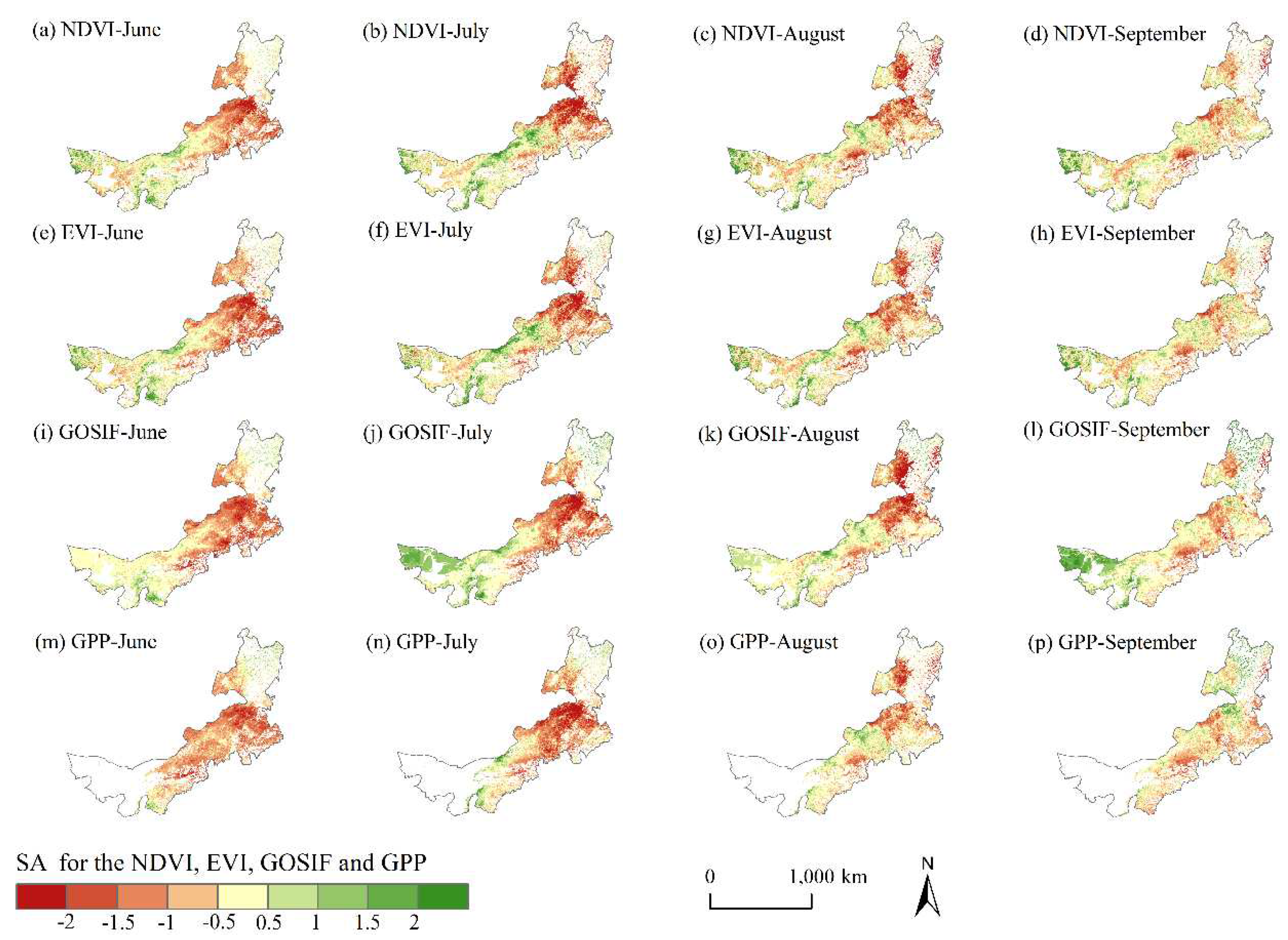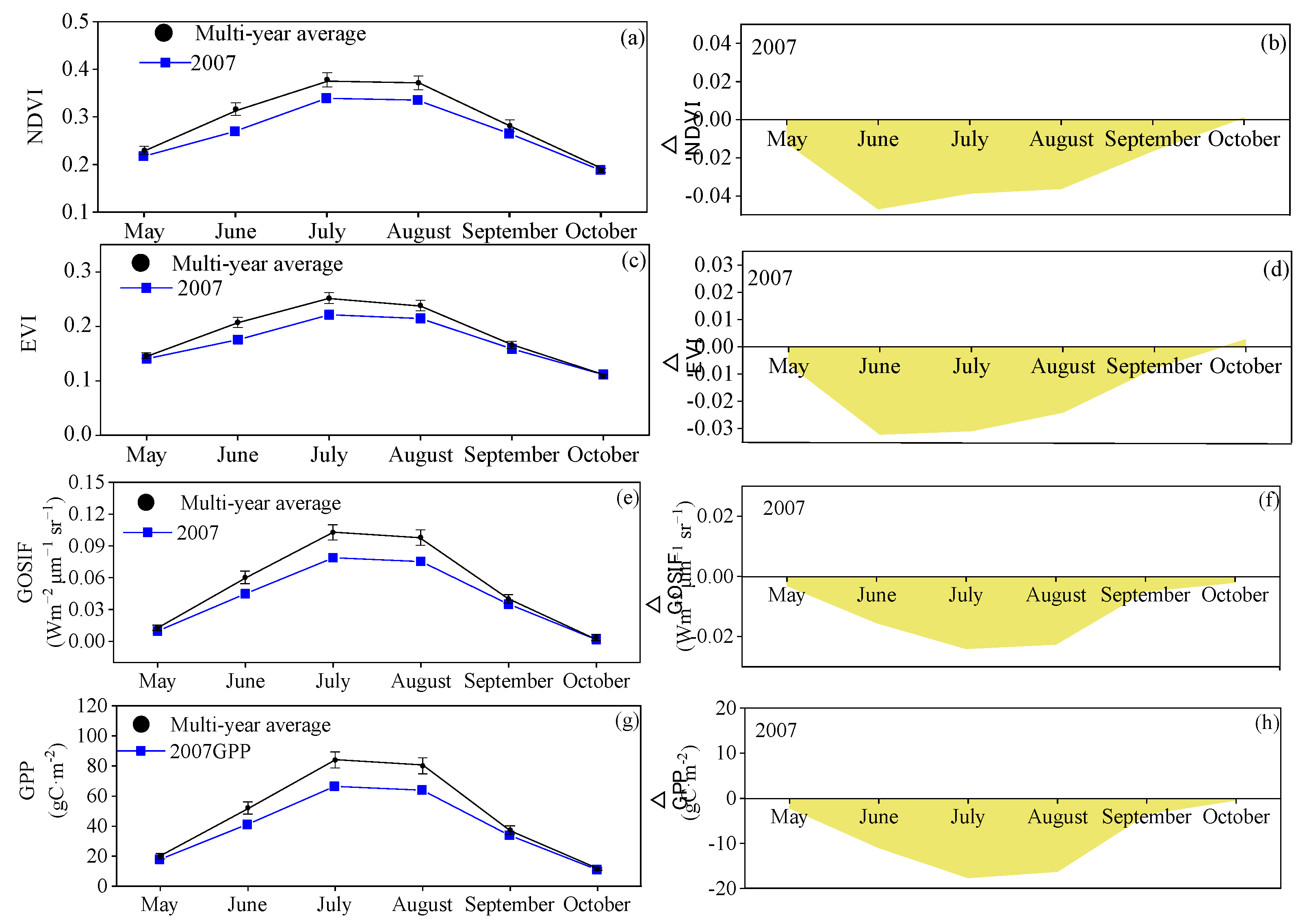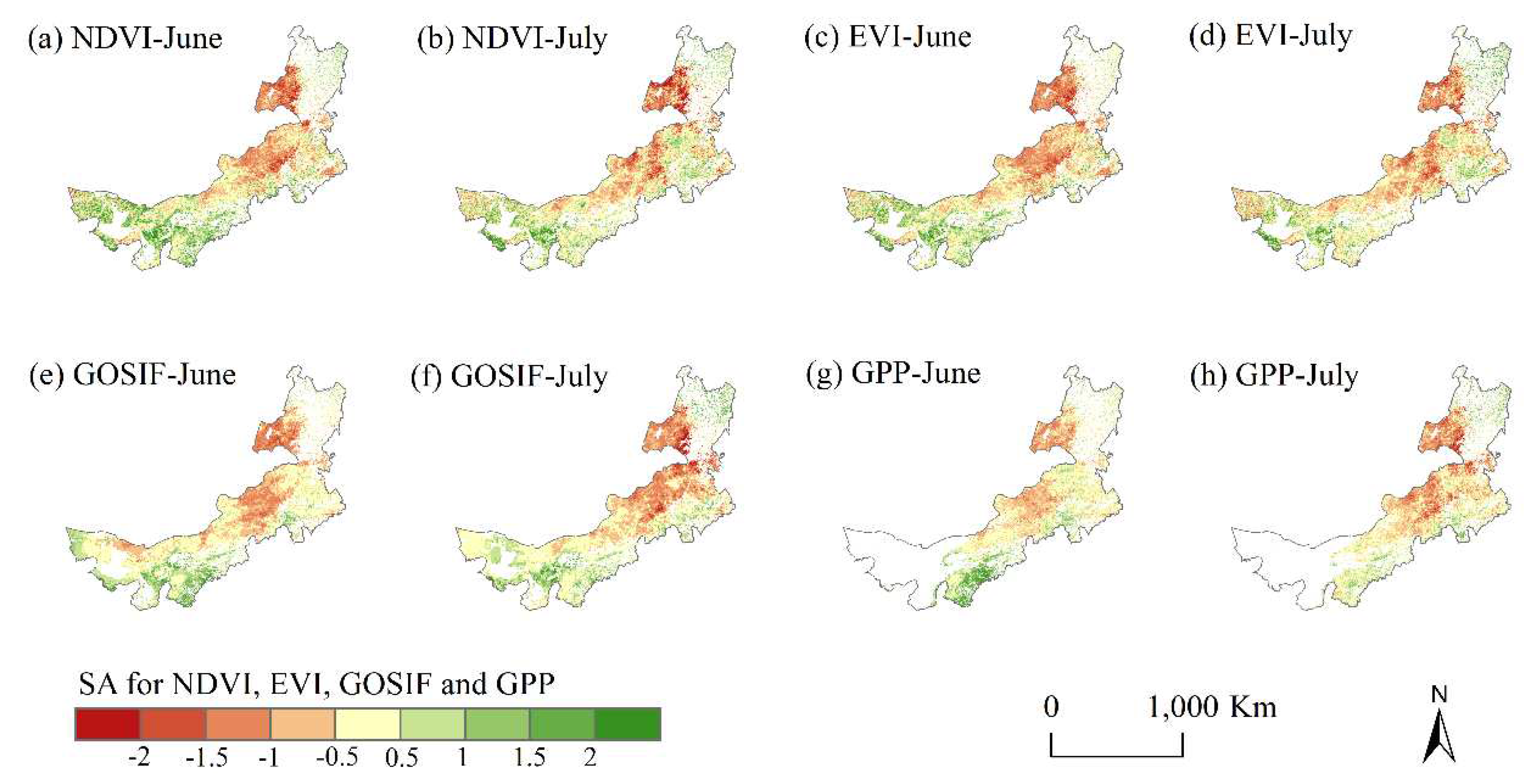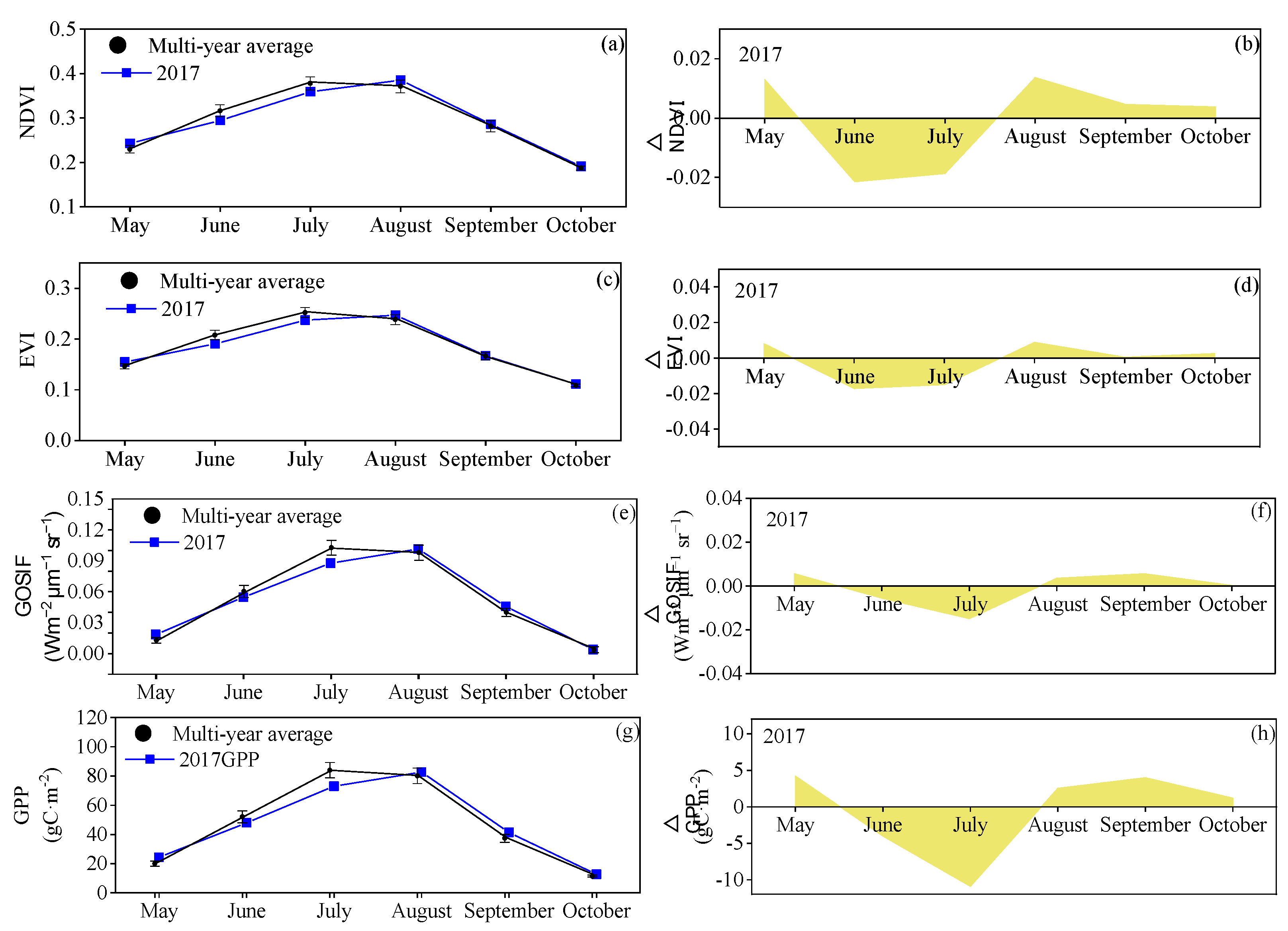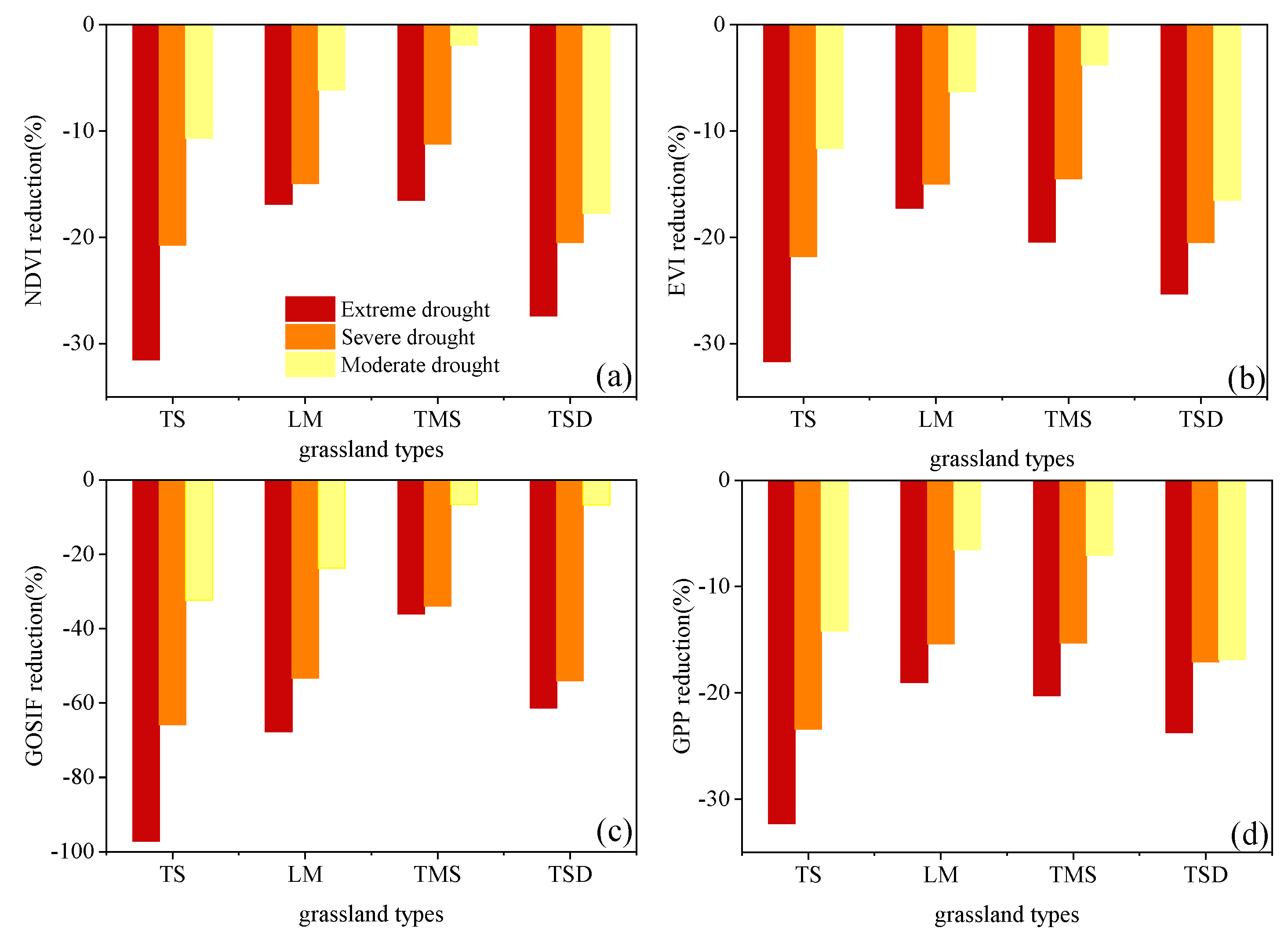1. Introduction
Drought is a common hydrometeorological phenomenon and a significant environmental risk that increases vegetation mortality and reduces vegetation productivity [
1,
2,
3,
4]. For the past several decades, the frequency and severity of drought events have shown a rapidly increasing trend with temperature rising [
5,
6,
7]. Earth system models also project a vast expansion of regions often affected by extreme and severe droughts in the coming decades [
8,
9]. Grassland areas cover approximately 25% of the Earth's land surface, yet they store approximately 34% of global terrestrial carbon storage [
10,
11,
12]. Grasslands are among the most fragile ecosystems and are highly susceptible to droughts [
10,
11]. Recently, some research have indicated that drought is recognized as the key forcing on grassland ecosystem dynamics [
10,
11,
13]. Therefore, it is important to study the response of grassland vegetation growth to drought under the background of global warming.
Remote sensing observations have proven to be invaluable in monitoring drought characteristics and quantifying its impact on grasslands over varying time intervals and spatial scales [
14,
15]. Recently, remote sensing approaches have developed and widely applied vegetation indices (e.g.; the Normalized Difference Vegetation Index (NDVI), the Enhanced Vegetation Index (EVI), Near-Infrared Reflectance of Vegetation (NIRv)) and drought indices (e.g.; the Temperature-Vegetation Dryness Index (TVDI), the Soil Water Deficit Index (SWDI), the Standardized Precipitation Evapotranspiration Index (SPEI), etc.) to assess the effects of drought events on grassland ecosystems [
3,
16]. Traditionally used vegetation indices (such as NDVI, EVI and NIRv) do not directly reflect changes in actual photosynthesis in grassland ecosystems when water stress occurs [
11,
17,
18]. Some studies have also used Solar-induced Chlorophyll Fluorescence (SIF) to monitor vegetation response to drought events at different spatial and temporal scales [
11,
16,
19,
20]. Unlike traditional vegetation indices, SIF is directly related to the actual photosynthetic function of plants and can reveal rapid changes in water stress within the vegetation canopy [
21,
22]. However, the degree of change in photosynthesis or productivity is highly sensitive to different drought-levels [
10,
23]. Generally, extreme and severe drought events can result in additional reductions in grassland photosynthesis or productivity due to increased mortality and physiological function recession [
23]. Previous studies have primarily focused on the effect of specific drought levels on grassland, leaving the response of grassland ecosystems to different intensities of drought largely unexplored. Moreover, different types of grassland ecosystems exhibit varying responses to droughts. Therefore, a more precise investigation into the spatiotemporal evolution patterns of grassland ecosystems and their response to different drought-levels is warranted.
Inner Mongolia is highly responsive to global climate change, with more than 74% of its area covered by various types of grasslands [
24,
25]. This region has experienced increased temperatures, reduced precipitation, and more frequent droughts over the past few decades [
25]. Understanding the spatial and temporal patterns of grassland NDVI, EVI, GOSIF, and GPP and their responses to different drought-levels in Inner Mongolia is of great significance for enhancing ecological security in Northern China [
25]. The primary objective of this study was to quantify the spatiotemporal variation in the characteristics of grassland ecosystems and their response to different intensities of drought in Inner Mongolia over the past two decades (2002-2020) using NDVI, EVI, GOSIF, GPP, SPEI and soil moisture (SM) data. Additionally, we assessed variation in NDVI, EVI, GOSIF, and GPP losses in different grassland types under the same drought severity levels. This study aimed to answer the following questions: (1) What are spatial and temporal patterns in the characterization of Inner Mongolia grasslands, such as NDVI, EVI, GOSIF and GPP? (2) To what extent do typical drought events influence grassland ecosystems in Inner Mongolia? (3) How do NDVI, EVI, GOSIF, and GPP reductions vary in different grassland biomes under different drought levels? Our results provide a more robust and less the uncertain understanding by applying a single data source and scientific basis to examine grassland ecosystems’ responses to droughts at various levels.
2. Materials and Methods
2.1. Study area
The Inner Mongolia, situated between 37
◦ 24′N to 53
◦ 23′N and 97
◦ 12′E to 126
◦ 04′E, is located in northern China and covers an expansive area of approximately 118.3×10
4 km
2. The topography is characterized as long and narrow, with elevations decreasing from the southwest to the northeast (
Figure 1). Influenced significantly by the Asia monsoon, Inner Mongolia is a typical temperate continental monsoon climate. Consequently, the mean annual rainfall varies from 50 to 550 mm and diminishes from the northeast to the southwest [
24,
26,
27]. The annual mean temperature typically falls within the range of -4~10℃, and progressively increases from the northeast to the southwest [
25,
26,
27,
28]. Grasslands dominate the Inner Mongolia landscape, constituting the primary vegetation types and covering approximately 74% of the entire region. Nevertheless, due to the temporal variability of precipitation and the effects of global warming, Inner Mongolia has experienced a heightened frequency droughts over the past decades [
13,
29].
2.2. Data sources and preprocessing
2.2.1. MODIS products
In this study, Moderate Resolution Imaging Spectroradiometer (MODIS) products, specifically NDVI, EVI, and GPP were used to monitor the vegetation because of their high-quality data sources (
https://e4ftl01.cr.usgs.gov/). NDVI and EVI obtained used with a1-month temporal resolution and a 0.05°spatial resolution of from the MOD13C2 product. To mitigate the impact of aerosol and atmospheric and molecular scattering, the maximum value composite (MVC) method was used to generate yearly NDVI and EVI datasets [
30]. GPP data were sourced from the MOD17A2H product, featuring a temporal resolution of 8-day and a spatial resolution of 500 m. The monthly and yearly GPP data to achieve spatial resolution of 0.05°, starting from 8-day data were synthesized and resampled [
31]. The period from 2002 to 2020 was considered in this study.
2.2.2. GOSIF data
A global Orbiting Carbon Observatory-2 (OCO-2) Solar-induced chlorophyll fluorescence (SIF) dataset, known as GOSIF measured in W·m
-2·μm
-1·sr
-1, covering the period from January 2002 to December 2020 were retrieved from the following website:
http://data.globalecology.unh.edu/data/GOSIF_v2/. GOSIF was developed by integrating discrete OCO-2 SIF soundings, remote sensing data from MODIS, and meteorological reanalysis data [
32]. It offers global coverage with high spatial and temporal resolutions (0.05°and 8 days). GOSIF has gained widespread use in assessing terrestrial photosynthesis and studying vegetation responses to drought under the background of global climate change [
32,
33,
34]. In this study, monthly and yearly GOSIF data was used to evaluate its effectiveness in tracking vegetation changes and monitoring drought conditions.
2.2.3. SPEI data
The SPEI dataset was originally proposed by Vicente-Serrano et al. (2010)[
35]. It is calculated based on available water (monthly precipitation) and atmospheric evaporation demand (potential evapotranspiration) and offers the advantage of providing multi-time scale data while accounting for potential evapotranspiration in drought assessments [
36]. SPEI has been widely used in numerous studies to assess drought trends [
23,
37,
38]. The SPEI version 2.8 is available for access at the following website:
https://digital.csic.es/handle/10261/288226. Considering the SPEI with three-month time scale (SPEI-3) can better reflect the severity and duration of grassland drought [
25], SPEI-3 was used to assess the effect of drought events on grassland vegetation growth in Inner Mongolia. The SPEI values and corresponding drought levels were described in
Table 1 [
35,
39].
2.2.4. Soil moisture data
Climate Change Initiative (CCI) SM dataset, which provides surface soil moisture information, is a product of by the European Space Agency (ESA) CCI [
40,
41]. The latest release (v07.1) spans 43 years from November 1978 to December 2021, and is accessible at this link:
https://catalogue.ceda.ac.uk/uuid/. The SM CCI COMBINED dataset, which has a spatial resolution of 0.25°×0.25° and a volumetric unit (m
3/m
3), were selected to assess drought conditions in the Inner Mongolia grassland from 2002 o 2020. The reliability of the dataset has been validated in various regions worldwide [
42,
43,
44].
2.2.5. Other data
The climate class was characterized by the aridity index (AI), which is computed based on annual precipitation, annual temperature, and annual reference evapo-transpiration (ET0) data from the 1970-2000 period. This dataset is accessible at
https://csidotinfo.wordpress.com/data/global-aridity-and-pet-database/. In this study, the Hyper Arid (AI<0.03), Arid (0.03<AI≤0.2), Semi-Arid (0.2<AI≤0.5), Dry sub-humid (0.5<AI≤0.65), and Humid (AI>0.65) were categorized by AI values in Inner Mongolia (
Figure 1b) [
45,
46].
The classification of grassland types in Inner Mongolian of China was obtained from the Inner Mongolian Institute of Grassland Surveying and Planning [
47,
48]. The Inner Mongolian grassland comprises predominant types, including temperate steppe (TS), temperate meadow-steppe (TMS), temperate desert type (TD), temperate steppe-desert (TSD), lowland meadow (LM), Marsh, and temperate mountain meadow (TMM) (
Figure 1a).
2.3. Subsection
2.3.1. Theil-Sen Median trend and M-K test
Theil-Sen Median slope and Mann–Kendall (M-K) nonparametric trend analysis methods were used to assess the change trends in NDVI, EVI, GOSIF, and GPP during the period from 2002 to 2020. This method is favored for their simplicity, computational efficiency, and robustness against data distribution or measurement errors. The calculation of the trend (
β) is performed using the following equations [
49,
50,
51]:
where β denotes the change trend, n denotes the length of the time series of NDVI, EVI, GOSIF, and GPP, sgn is the sign function, i and j are serial numbers, xi and xj denote the values at moments i and j, respectively. β >0 indicates an increasing trend; β <0 indicates a decreasing trend. |Z|≥1.96 represent the change trend is significant at 0.05 confidence level.
2.3.2. Standardized Anomaly
The calculation standardized anomaly (SA) for each variable at the pixel level during the
ith month of a drought period can be performed using the following equation [
2,
52]:
where, SAgrassland (i, j) and Var(i, j) is the standardized anomaly and value of each variable (CCI-SM, NDVI, EVI, GOSIF, GPP) at the ith grid for the jth month during the drought period, respectively; and is the average and standard deviation of each variable at the ith grid for the jth month during 2002-2020, respectively.
2.3.3. Grassland NDVI, EVI, GOSIF and GPP loss assessment
NDVI, EVI, GOSIF and GPP reductions induced by drought are calculated as the difference between the mean values of NDVI, EVI, GOSIF and GPP during drought years reference years [
10].
where represent the percentage reduction in NDVI, EVI, GOSIF and GPP during drought years, Vardrought and Varmean denote the value of NDVI, EVI, GOSIF and GPP during drought years (SPEI-12<-1.0) and near normal years (-1.0<SPEI-12≤1.0), respectively.
3. Results
3.1. Spatio-temporal patterns of NDVI, EVI, GOSIF, and GPP from 2002 to 2020
Figure 2a illustrates the change trends in monthly grassland NDVI and EVI from 2002 to 2020, revealing apparent periodical characteristics with a one-year cycle. Notably, the maximum values of grassland NDVI, reaching around 0.40, consistently occurred in July or August each year, signifying the period when grassland growth and metabolism were most vigorous. Conversely, the minimum values of grassland NDVI, dropped below 0.1, were consistently observed in January, indicating minimal grassland growth during that period. The change trends of monthly grassland EVI exhibited similar patterns to NDVI, but the fluctuation range of EVI values was lower than NDVI (
Figure 2a). Monthly grassland GOSIF and GPP also displayed clear periodic characteristics throughout the period from 2002 to 2020 (
Figure 2b). GOSIF exhibited patterns similar to those of GPP, with the maximum value appearing in August 2018, reaching 0.1371 W·m
-2·μm
-1·sr
-1. Conversely, the minimum GOSIF value was recorded in February 2014, with a value of -0.0121 W·m
-2·μm
-1·sr
-1. In the case of grassland GPP, its maximum value was observed in July 2012, reaching 126.61 gC·m
-2·month
-1. Overall, the monthly variations grassland NDVI, EVI, GOSIF and GPP consistently exhibited a one year cycle in Inner Mongolia between 2002 and 2020.
In
Figure 3, the yearly trends of NDVI, EVI, GOSIF and GPP from 2000 to 2020 are depicted. All four variables exhibited significant increasing trends during this period, with change rates of 0.0024 a
-1, 0.0018 a
-1, 0.0012 W·m
-2·μm
-1·sr
-1·a
-1 and 4.6950 gC·m
-2·a
-1, respectively (
P<0.01). The peak values for grassland NDVI, EVI, GOSIF and GPP were observed in 2018, reaching 0.4617, 0.3145, 0.1394 W·m
-2·μm
-1·sr
-1 and 447.7892 gC·m
-2, respectively. Conversely, the minimum lowest values for grassland NDVI and EVI were recorded in 2009 at 0.3593 and 0.2381 (
Figure 3a), while the lowest values for grassland GOSIF and GPP were observed in 2007, with values of 0.0856 W·m
-2·μm
-1·sr
-1·a
-1 and 322.67 gC·m
-2·a
-1 (
Figure 3b).
Figure 4 illustrates the spatial patterns and change trends of grassland NDVI, EVI, GOSIF, and GPP in Inner Mongolia between 2002 and 2020. The annual mean values of these variables showed similar spatial distribution characteristics, gradually increasing from the northwest to the southeast (
Figure 4a-4d). High values were primarily concentrated in the eastern part of t Inner Mongolia, including LM and TMS regions (
Figure 4a-4d and
Figure 1), while lower values prevailed in the western orgions, which are predominantly TD and TSD (
Figure 4a-4d and
Figure 1). Spatial variability in grassland change trends across Inner Mongolia from 2002 to 2020 was evident. For NDVI and EVI, approximately 82.13% and 80.18% of the region displayed increasing trends. Notably, 25.83% and 21.18% of the grassland NDVI and EVI values showed significant increasing trends, primarily concentrated in Tongliao, Ordos and Alxa League (
Figure 1 and
Figure 4e-4f). Conversely, only 0.91% and 0.82% of the grassland NDVI and EVI values exhibited significant decreasing trends, scattered in areas such as Chifeng and Alxa League (
Figure 1 and
Figure 4e-4f). As for grassland GOSIF and GPP, the areas showing increasing trends (84.42% and 96.89%) were substantially higher than those with decreasing trends (15.58% and 3.11%). Specifically, 22.65% and 48.13% of grassland GOSIF and GPP values showed significant increasing trends, primarily distributed in Xingan League, Tongliao, Chifeng, Ordos and Alxa League. These regions are mainly covered by TS, TSD, and TMS (
Figure 1). Conversely, only 0.50% and 0.26% of the grassland GOSIF and GPP values showed significant decreasing trends in the study area.
3.2. Changes of drought from 2002 to 2020
Figure 5 indicated the SPEI and standardized anomaly of CCI-SM (SA
CCI-SM) change trends from 2002 to 2020 in Inner Mongolia grassland. As shown in
Figure 5, SPEI values exhibited frequent fluctuations at 1-month time (SPEI-1) or 3-month time (SPEI-3), while remaining relatively stable at longer time scales (SPEI-12). The pronounced amplitude and higher frequency of wet and dry changes were primarily associated with SPEI-1 (
Figure 5a). From 2002 to 2020, Inner Mongolia grassland experienced a total of 96 drought months including 50 mild droughts, 33 moderate droughts, 12 severe droughts, and one extreme drought month. Among these, the lowest SPEI-1 value (-2.05) was recorded in March 2019 (
Figure 5a). In contrast, SPEI-3 exhibited greater stability and provided insight into seasonal scale dry-wet changes. During the same period, a total of 119 drought months were recorded, comprising 54 mild droughts, 48 moderate droughts, 14 severe droughts, and 3 extreme droughts. The lowest SPEI-3 value (-2.08) occurred in June 2017 (
Figure 5b). SPEI-12, reflecting the annual scale dry-wet variation, and was the most stable among the three indices. From 2002 to 2012, SPEI-12 identified 57 mild droughts, 71 moderate droughts, 23 severe droughts and 6 extreme droughts. The lowest SPEI-12 value (-2.11) was found in March 2018 (
Figure 5c). In particular, SPEI-3 values were observed as -1.34, -1.45, -1.42, and -1.33 in June, July, August, and September 2007, respectively, and -2.08 and -2.0 in June and July 2017, respectively (
Figure 5b).
The soil moisture status of Inner Mongolia grassland was identified by the SA
CCI-SM (
Figure 5d). From 2002 to 2020, a total of 112 drought months were identified by the soil moisture (SA
CCI-SM<0), with a minimum value of SA
CCI-SM appearing in December 2020 (SA
CCI-SM =-2.54). Notably, from June 2007 to September 2007, SA
CCI-SM values consistently fell below -1 in Inner Mongolia grassland. Specifically, in June, July, August, September 2007, SA
CCI-SM values were -1.59, -1.30, -1.71, and -1.91, respectively. In June and July 2017, SA
CCI-SM values were -1.02 and -1.12, respectively (
Figure 5d). Considering with the droughts indicated by SPEI-3 and SA
CCI-SM, June 2007 to September 2007 and June 2017 to July 2017 were selected to analyze the response of grassland vegetation growth to droughts.
Figure 6 and
Figure 7 present the spatial patterns of SPEI-3 and SA
CCI-SM in Inner Mongolia grassland for the years in 2007 and 2017. As illustrated in
Figure 6, the percentage of grassland areas affected by severe and extreme drought was 47.98%, 59.24%, 63.01%, and 64.16%, respectively (
Figure 6a-6d). These regions are primarily situated in the central eastern part of Inner Mongolia, with milder drought conditions observed in the western regions. The spatial distribution of SA
CCI-SM closely mirrored that of SPEI-3. The proportion of areas with SA
CCI-SM values less than -1 was 61.38%, 48.37%, 41.31% and 54.23%, respectively (
Figure 6e-h). In June and July 2017, 61.27% and 56.36% of the grassland area showed extreme drought conditions, concentrated in the central eastern part of Inner Mongolia (
Figure 7a and 7b). Spatial distribution of SA
CCI-SM closely paralleled that of SPEI-3, with proportions of areas experiencing SA
CCI-SM values less than -1 at 50.80% and 45.70%, respectively (
Figure 7c and 7d).
3.3. Divergent grassland vegetation growth response to two drought events
Figure 8 and
Figure 9 showed the spatial distributions of SA for NDVI, EVI, GOSIF and GPP during June, July, August, September 2007, as well as June and July 2017. Spatially, both NDVI and EVI indicated widespread declines (SA<-0.5) in during these months, particularly in east-central regions of Inner Mongolia (SA < -2) (
Figure 8a-h). Specifically, NDVI decreased by 17.39%, 11.38%, 10.80% and 6.18% in June (-0.047), July (-0.039), August (-0.036) and September (-0.016), respectively, relative to the multi-year average (
Figure 9a and 9b). Similarly, EVI declined by 18.33%, 13.97%, 11.24% and 4.98% in June, July, August, and September, confirming a widespread vegetation browning phenomenon following drought from June to September 2007. Compared to NDVI and EVI, GOSIF indicated a similar spatial distribution pattern but displayed more drastic changes from June to September (
Figure 8i-l). GOSIF decreased by 34.37%, 30.42%, 29.88% and 14.12% in June (-0.015 Wm
-2 μm
-1 sr
-1), July (-0.024 Wm
-2 μm
-1 sr
-1), August (-0.023 Wm
-2 μm
-1 sr
-1), and September (-0.005 Wm
-2 μm
-1 sr
-1), respectively, relative to the multi-year average (2002-2020) (
Figure 9e and 9f). The spatial distributions of SA for GPP indicated a net loss in carbon sequestration relative to the multi-year average becauseof the drought events. As a result, GPP decreased by 26.59%, 26.51%, 25.41%, and 10.28% in June (-10.93 gCm
-2), July (-17.58 gCm
-2), August (-16.23 gCm
-2), and September (-3.48 gCm
-2), respectively, relative to the multi-year average (2002-2020) (
Figure 9g and 9h).
In June-July 2017, NDVI, EVI, GOSIF and GPP revealed a significant inhibition of grassland vegetation growth in east-central Inner Mongolia (SA < -0.5) (
Figure 10). NDVI decreased by 7.31% and 5.22% in June (-0.022) and July (-0.019), respectively (
Figure 11a and 11b). Similarly, EVI exhibited reductions of 9.05% and 6.36% in June (-0.017) and July (-0.015), respectively (
Figure 11c and 11d). Under the influence of drought stress, GOSIF decreased 10.20% and 17.01% in June (-0.006 Wm
-2 μm
-1 sr
-1) and July (-0.015 Wm
-2 μm
-1 sr
-1), respectively, signifying a clear inhibition of grassland vegetation growth (
Figure 11e and 11f). GPP decreased by 8.33% and 14.91% in June (-4.001 gCm
-2) and July (-10.893 gCm
-2), respectively (
Figure 11g and 11h). Notably, the decrease in GPP in June was less pronounced than in July. This differential response was particularly evident in GOSIF, while NDVI and EVI failed to capture this variability. Therefore, GOSIF emerges as a superior indicator for assessing the impact of drought events on grassland photosynthesis.
Based on the responses of NDVI, EVI, and GOSIF to two drought events, NDVI, EVI, and GOSIF experienced water stress during the peak growth stage of grassland vegetation. However, GOSIF exhibited a more pronounced response to drought, with its change trend closely mirroring that of GPP. Therefore, GOSIF serves as a valuable indicator that closely reflects the processes associated with GPP during drought events.
3.4. NDVI, EVI, GOSIF and GPP loss in different drought-levels
In order to evaluate the impacts of different drought severities levels events in grassland vegetation, we examined the NDVI, EVI, GOSIF, and GPP reductions across varying drought severities in Inner Mongolia. In general, all levels of drought (moderate, severe, and extreme) led to the declines in NDVI, EVI, GOSIF, and GPP (
Table 2). However, the extent of NDVI, EVI, GOSIF, and GPP reductions varied significantly. For NDVI, the average reductions caused by moderate, severe, and extreme droughts were 8.82%, 14.46% and 26.81%, respectively. Similarly, EVI exhibited average reductions of 8.71%, 15.04% and 27.11% under moderate, severe, and extreme droughts conditions, respectively. Notably, GOSIF showed much larger reductions in grassland of the Inner Mongolia, with reductions of 20.58%, 22.83% and 67.31% under moderate, severe, and extreme droughts, respectively. For GPP, the average reductions caused by moderate, severe, and extreme droughts was 10.52%, 18.01% and 27.05%, respectively. Overall, NDVI, EVI, GOSIF, and GPP exhibited decreased significant declines with increasing drought severity, with GOSIF displaying the most pronounced response to drought.
The reductions in NDVI, EVI, GOSIF, and GPP across various grassland types along the drought severity gradient exhibit notable differences (
Figure 12). During extreme drought conditions, the most significant NDVI reductions were observed in TS, with an average loss of -31.54%. LM, TMS, and TSD was also experienced substantial NDVI reductions, with average-16.88%, -16.52%, and -27.37% (
Figure 12a). A similar pattern was observed for EVI reductions, where TS, LM, TMS, and TSD exhibited reductions of -31.69%, -17.25%, -20.45%, and -25.30%, respectively (
Figure 12b). Remarkably, GOSIF reductions were most pronounced in TS, with an average loss of -92.15%, followed by LM (-67.72%), TSD (-61.37%), and TMS (-36.08%) (
Figure 12c). Regarding GPP, TS experienced the highest average loss (-32.29%), followed by TSD (-23.73%), TMS (-20.28%), and LM (-19.01%) (
Figure 12d). For severe drought conditions, GOSIF reductions in TS, LM, TMS, and TSD were -65.83%, -53.23%, -33.96%, and -53.94%, respectively (
Figure 12c). GPP exhibited average losses of -23.42%, -15.40%, -15.28%, and -16.87%, in TS, LM, TMS, and TSD, respectively (
Figure 12d). These findings highlight the significant variation in NDVI, EVI, GOSIF and GPP reductions across different grassland types within the context of the same level of drought. TS displayed the most substantial decrease ratio, while TMS exhibited the smallest decrease ratio.
4. Discussion
4.1. NDVI, EVI, GOSIF and GPP loss in different drought-levels
In this study, an overall decrease of grassland vegetation growth during the 2007 and 2017 drought events was found in Inner Mongolia (
Figure 8 and
Figure 10). This finding aligns with similar observations in other regions, such as southwest or northern China, U.S. Midwest, the tropical Amazon and temperate Europe [
2,
53,
54]. Moreover, we found that the decrease in grassland GOSIF was much more substantial than that observed in NDVI and EVI during 2007 and 2017 drought events (
Figure 9 and
Figure 11). This heightened sensitivity of GOSIF to drought event in Inner Mongolia’s grassland is significant. SIF captures information about vegetation photosynthesis, such as Absorbed Photosynthetically Active Radiation (FPAR) and light use efficiency [
55]. As a sensitive indicator of vegetation photosynthesis, SIF can more realistically and sensitively reflect variations in canopy photosynthesis compared to traditional vegetation indices [
18]. For example, studies conducted in the U.S. Midwest and Hulun Buir grassland have demonstrated that GOSIF is more sensitive to drought than NDVI and EVI [
19,
54]. Previous studies have also highlighted the superior performance of SIF is capturing variations in GPP during drought events [
36,
54]. Our findings further support the viewpoint which the trend in GPP closely aligns with that of GOSIF during 2007 and 2017 drought events (
Figure 9 and
Figure 11).
4.2. NDVI, EVI, GOSIF and GPP response under different drought severities
This study also quantified the grassland NDVI, EVI, GOSIF and GPP loss under different drought severity levels, and reductions variation in different grassland types within the context of the same drought level, which is critical for identifying grassland most sensitive to severe and extreme drought events (
Table 2 and
Figure 12). Our finding confirmed that NDVI, EVI, GOSIF and GPP all exhibited substantial decrease as drought severity increased, aligning with previous researches [
10,
24]. For different grassland types, TS ecosystems were the most vulnerable to severe and extreme droughts in Inner Mongolia. TS regions, primarily studied in the semi-arid region of central Inner Mongolia (
Figure 1b), displayed the highest reduction rates. This heightened vulnerability can be attributed to the unique characteristics of semi-arid ecosystems, which tend to exhibit the most pronounced physiological and functional responses to drought stress [
24,
56,
57]. These findings align with similar observations in other semi-arid regions, such as southeastern Australia.
The TSD ecosystems exhibited the second-largest reduction in response to drought. TSD regions are mostly found in the arid western part of Inner Mongolia (
Figure 1). While TSD ecosystems have adapted to living in arid conditions, extreme or severe droughts can still have detrimental effects. These conditions can lead to structural changes and reduced photosynthesis, as observed in our study and supported by previous research [
24,
56].
4.3. Uncertainties
While this study provides valuable insights NDVI, EVI, GOSIF, and GPP trends and their responses to droughts in Inner Mongolia grassland, several limitations should be considered. Firstly, although GOSIF dataset, while offering continuity in spatiotemporal distribution, features relatively coarse resolution (0.05°×0.05°). Additionally, GOSIF is derived from a machine learning method based on OCO-2 satellite data, which introduces certain internal uncertainties [
22,
32]. Secondly, previous studies found the grasslands in Inner Mongolia may experience by compound droughts [
58]. This study focused on the response to individual drought events, and further research should investigate how grassland vegetation responds to these more complex and compounded drought scenarios. Moreover, this study assessed the impact of SPEI on grassland vegetation. The vapor pressure deficit (VPD), soil moisture and human activities can also affect vegetation growth [
59,
61], and ignoring these variables will inevitably result in some uncertainties of the presented results. Therefore, these questions will need to be discussed and analyzed in future studies.
5. Conclusions
In this study, we utilized NDVI, EVI, GOSIF, GPP, and drought indices to assess the effect of drought events on grassland ecosystems in Inner Mongolia of China. Our investigation aimed to uncover spatiotemporal evolution patterns of grassland dynamics and evaluate how different drought severity levels affect various grassland types. This study shows that NDVI, EVI, GOSIF, and GPP exhibited significant increasing trends from 2000 to 2020, with 25.83%, 21.18%, 22.65% and 48.13% of the grassland areas, respectively. Compared with NDVI and EVI, the responses of GOSIF to drought more intense, and it can better reflect the impact of drought events on grassland photosynthesis in 2007 and 2017. The reductions in NDVI, EVI, GOSIF, and GPP intensified as drought severity levels increased. The influence of drought events on NDVI, EVI, GOSIF, and GPP reductions in different grassland types under extreme drought conditions was obviously different, and the effects of different drought-levels in same grassland type were also exist difference. These findings underscore the critical importance of effectively managing land carbon cycling and addressing the challenges posed by climate change, particularly in regions like Inner Mongolia, where grassland ecosystems play a vital role.
Author Contributions
“Conceptualization, A.Zhao. and X.Zhu.; methodology, A.Zhao.; software, R.Xu.; validation, A.Zhao.; R.Xu. and L.Zou.; formal analysis, R.Xu.; investigation, R.Xu.; resources, X.Zhu.; data curation, A.Zhao.; writing—original draft preparation, L.Zou.; writing—review and editing, A.Zhao.; visualization, A.Zhao.; supervision, A.Zhao.; project administration, X.Zhu.; funding acquisition, Y.Y. All authors have read and agreed to the published version of the manuscript.”
Funding
Please add: “This research received no external funding” or “This research was funded by he National Key Research and Development Program of China, grant number 2021YFB3901201” and “National Natural Science Foundation of Hebei Province, China, grant number D2022402030.
Acknowledgments
This study was financially supported by the National Key Research and Development Program of China (No.2021YFB3901201), the National Natural Science Foundation of Hebei Province, China (No. D2022402030).
Declaration of Competing Interest
All authors declare that No conflict of interest exists.
References
- Heim, R.R. A review of twentieth-century drought indices used in the United States. Bull. Am. Meteorol. Soc. 2002, 83, 1149–1166. [Google Scholar] [CrossRef]
- Li, X.; Li, Y.; Chen, A.; Gao, M.; Slette, I.J.; Piao, S. The impact of the 2009/2010 drought on vegetation growth and terrestrial carbon balance in Southwest China. Agr. Forest. Meteorol. 2019, 269, 239–248. [Google Scholar] [CrossRef]
- West, H.; Quinn, N.; Horswell, M. Remote sensing for drought monitoring & impact assessment: Progress, past challenges and future opportunities. Remote. Sens. Environ. 2019, 232, 111291. [Google Scholar] [CrossRef]
- AghaKouchak, A.; Huning, L.S.; Sadegh, M.; Qin, Y.; Markonis, Y.; Vahedifard, F.; Love, C.A.; Mishra, A.; Mehran, A.; Obringer, R.; Hjelmstad, A.; Pallickara, S.; Jiwa, S.; Hanel, M.; Zhao, Y.; Pendergrass, A.G.; Arabi, M.; Davis, S.J.; Ward, P.J.; Svoboda, M.; Pulwarty, R.; Kreibich, H. Toward impact-based monitoring of drought and its cascading hazards. Nat. Rev. Earth. Env. 2023, 4, 582–595. [Google Scholar] [CrossRef]
- Bennett, A.C.; McDowell, N.G.; Allen, C.D.; Anderson-Teixeira, K.J. Larger trees suffer most during drought in forests worldwide. Nat. Plants. 2015, 1, 15139. [Google Scholar] [CrossRef] [PubMed]
- Feng, W.; Lu, H.; Yao, T.; Yu, Q. Drought characteristics and its elevation dependence in the Qinghai–Tibet plateau during the last half-century. Sci. Rep-UK, 2020, 10, 14323. [Google Scholar] [CrossRef]
- Liu, Y.; Dang, C.; Yue, H.; Lyu, C.; Dang, X. Enhanced drought detection and monitoring using sun-induced chlorophyll fluorescence over Hulun Buir Grassland, China. Sci. Total. Environ. 2021, 770, 145271. [Google Scholar] [CrossRef]
- Vicente-Serrano, S.M.; Quiring, S.M.; Pena-Gallardo, M.; Yuan, S.; Dominguez-Castro, F. A review of environmental droughts: Increased risk under global warming? Earth-Sci. Rev. 2020, 201, 102953. [Google Scholar] [CrossRef]
- Cao, D.; Zhang, J.; Han, J.; Zhang, T.; Yang, S.; Wang, J.; Prodhan, F.A.; Yao, F. Projected increases in global terrestrial net primary productivity loss caused by drought under climate change. Earths. Future. 2022, 10, e2022EF002681. [Google Scholar] [CrossRef]
- Lei, T.; Feng, J.; Lv, J.; Wang, J.; Song, H.; Song, W.; Gao, X. Net Primary Productivity Loss under different drought levels in different grassland ecosystems. J. Environ. Manage. 2020, 274, 111144. [Google Scholar] [CrossRef]
- Wang, X.; Pan, S.; Pan, N.; Pan, P. Grassland productivity response to droughts in northern China monitored by satellite-based solar-induced chlorophyll fluorescence. Sci. Total. Environ. 2022, 830, 154550. [Google Scholar] [CrossRef]
- Deng, L.; Shangguan, Z.; Bell, S.M.; Soromotin, A.V.; Peng, C.; An, S.; Wu, X.; Xu, X.; Wang, K.; Li, J.; Tang, Z.; Yan, W.; Zhang, F.; Li, J.; Wu, J.; Kuzyakov, Y. Carbon in Chinese grasslands: meta-analysis and theory of grazing effects. Carbon. Res. 2023, 2, 19. [Google Scholar] [CrossRef]
- Sun, J.; Liu, W.; Pan, Q.; Zhang, B.; Lv, Y.; Huang, J.; Han, X. Positive legacies of severe droughts in the Inner Mongolia grassland. Sci. Adv. 2022, 8, eadd6249. [Google Scholar] [CrossRef]
- AghaKouchak, A.; Farahmand, A.; Melton, F.S.; Teixeira, J.; Anderson, M.C.; Wardlow, B.D.; Hain, C.R. Remote sensing of drought: Progress, challenges and opportunities. Rev. Geophys. 2015, 53, 452–480. [Google Scholar] [CrossRef]
- Jiao, W.; Wang, L.; McCabe, M.F. Multi-sensor remote sensing for drought characterization: current status, opportunities and a roadmap for the future. Remote. Sens. Environ. 2021, 256, 112313. [Google Scholar] [CrossRef]
- Jiao, W.; Wang, L.; Smith, W.K.; Chang, Q.; Wang, H.; D’Odorico, P. Observed increasing water constraint on vegetation growth over the last three decades. Nat. Commun. 2021, 12, 3777. [Google Scholar] [CrossRef] [PubMed]
- Meroni, M.; Rossini, M.; Guanter, L.; Alonso, L.; Rascher, U.; Colombo, R.; Moreno, J. Remote. sensing of solar-induced chlorophyll fluorescence: Review of methods and applications. Remote. Sens. Environ. 2009, 113, 2037–2051. [Google Scholar] [CrossRef]
- Xu, H.J.; Wang, X.P.; Zhao, C.Y. Drought sensitivity of vegetation photosynthesis along the aridity gradient in northern China. Int. J. Appl. Earth. Obs. 2021, 102, 102418. [Google Scholar] [CrossRef]
- Liu, Y.; You, C.; Zhang, Y.; Chen, S.; Zhang, Z.; Li, J.; Wu, Y. Resistance and resilience of grasslands to drought detected by SIF in inner Mongolia, China. Agr. Forest. Meteorol. 2021, 308-309, 108567. [Google Scholar] [CrossRef]
- Zhao, A.; Wang, D.; Xiang, K.; Zhang, A. ; Vegetation photosynthesis changes and response to water constraints in the Yangtze River and Yellow River Basin, China. Ecol. Indic. 2022, 143, 109331. [Google Scholar] [CrossRef]
- Mohammed, G.H.; Colombo, R.; Middleton, E.M.; Rascher, U.; van der Tol, C.; Nedbal, L.; Goulas, Y.; Pérez-Priego, O.; Damm, A.; Meroni, M.; Joanna, J.; Cogliati, S.; Verhoef, W.; Malenovský, Z.; Gastellu-Etchegorry, J.P.; Miller, J.R.; Guanter, L.; Moreno, J.; Moya, I.; Berry, J.A.; Frankenberg, C.; Zarco-Tejada, P.J. Remote sensing of solar-induced chlorophyll fluorescence (SIF) in vegetation: 50 years of progress. Remote. Sens. Environ. 2019, 231, 111177. [Google Scholar] [CrossRef] [PubMed]
- Zhang, T.; Zhou, J.; Yu, P.; Li, J.; Kang, Y.; Zhang, B. Response of ecosystem gross primary productivity to drought in northern China based on multi-source remote sensing data. J. Hydrol. 2023, 616, 128808. [Google Scholar] [CrossRef]
- Wang, Q.; Zeng, J.; Qi, J.; Zhang, X.; Zeng, Y.; Shui, W.; Xu, Z.; Zhang, R.; Wu, X.; Cong, J. A multi-scale daily SPEI dataset for drought characterization at observation stations over mainland China from 1961 to 2018. Earth. Syst. Sci. Data. 2021, 13, 331–341. [Google Scholar] [CrossRef]
- Wang, S.; Li, R.; Wu, Y.; Zhao, S. Vegetation dynamics and their response to hydrothermal conditions in Inner Mongolia, China. Glob. Ecol. Conserv. 2022, 34, e02034. [Google Scholar] [CrossRef]
- Tong, S.; Bao, G.; Bao, Y.; Huang, X. Monitoring of long-term vegetation dynamics and responses to droughts of various timescales in Inner Mongolia. Ecosphere. 2023, 14, e4415. [Google Scholar] [CrossRef]
- Tong, S.; Zhang, J.; Bao, Y. Inter-decadal spatiotemporal variations of aridity based on temperature and precipitation in Inner Mongolia, China. Pol. J. Environ. Stud. 2017, 26, 819–826. [Google Scholar] [CrossRef]
- Bian, Y.; Dai, H.; Zhang, Q.; Yang, L.; Du, W. Spatial distribution of potential evapotranspiration trends in the Inner Mongolia Autonomous Region (1971–2016). Theor. Appl. Climatol. 2020, 140, 1161–1169. [Google Scholar] [CrossRef]
- Chen, X.; Peng, J.; Li, H. Seasonal and regional differences of air temperature changes in Inner Mongolia. Geogr. Res. 2009, 28, 27–35. [Google Scholar]
- Cai, S.; Song, X.; Hu, R.; Leng, P.; Li, X.; Guo, D.; Zhang, Y.; Hao, Y.; Wang, Y. Spatiotemporal characteristics of agricultural droughts based on soil moisture data in Inner Mongolia from 1981 to 2019. J. Hydrol. 2021, 603, 127104. [Google Scholar] [CrossRef]
- Holben, B.N. Characteristics of maximum-value composite images from temporal AVHRR data. Int. J. Remote. Sens. 1986, 7, 1417–1434. [Google Scholar] [CrossRef]
- Li, M.; Chu, R.; Sha, X.; Xie, P.; Ni, F.; Wang, C.; Jiang, Y.; Shen, S.; Islam, A.R.M.T. Monitoring 2019 Drought and Assessing Its Effects on Vegetation Using Solar-Induced Chlorophyll Fluorescence and Vegetation Indexes in the Middle and Lower Reaches of Yangtze River, China. Remote. Sens-basel. 2022, 14, 2569. [Google Scholar] [CrossRef]
- Li, X.; Xiao, J. A global, 0.05-degree product of solar-induced chlorophyll fluorescence derived from OCO-2, MODIS, and reanalysis data. Remote. Sens-basel. 2019, 11, 517. [Google Scholar] [CrossRef]
- Mohammadi, K.; Jiang, Y.; Wang, G. Flash drought early warning based on the trajectory of solar-induced chlorophyll fluorescence. P. Natl. A. Sci. 2022, 119, e2202767119. [Google Scholar] [CrossRef] [PubMed]
- Yao, T.; Liu, S.; Hu, S.; Mo, X. Response of vegetation ecosystems to flash drought with solar-induced chlorophyll fluorescence over the Hai River Basin, China during 2001–2019. J. Environ. Manage. 2022, 313, 114947. [Google Scholar] [CrossRef] [PubMed]
- Vicente-Serrano, S.M.; Beguería, S.; López-Moreno, J.I. A multiscalar drought index sensitive to global warming: the standardized precipitation evapotranspiration index. J. Climate. 2010, 23, 1696–1718. [Google Scholar] [CrossRef]
- Zhang, R.; Bento, V.A.; Qi, J.; Xu, F.; Wu, J.; Qiu, J.; Li, J.; Shui, W.; Wang, Q. The first high spatial resolution multi-scale daily SPI and SPEI raster dataset for drought monitoring and evaluating over China from 1979 to 2018. Big. Earth. Data. 2023, 1–26. [Google Scholar] [CrossRef]
- Mohammed, S.; Alsafadi, K.; Enaruvbe, G.O.; Bashir, B.; Elbeltagi, A.; Széles, A.; Alsalman, A.; Harsanyi, E. Assessing the impacts of agricultural drought (SPI/SPEI) on maize and wheat yields across Hungary. Sci. Rep-UK. 2022, 12, 8838. [Google Scholar] [CrossRef]
- Musei, S.K.; Nyaga, J.M.; Dubow, A.Z. SPEI-based spatial and temporal evaluation of drought in Somalia. J. Arid. Environ. 2021, 184, 104296. [Google Scholar] [CrossRef]
- Zuo, D.; Cai, S.; Xu, Z.; Peng, D.; Kan, G.; Sun, W.; Pang, B.; Yang, H. Assessment of meteorological and agricultural droughts using in-situ observations and remote sensing data. Agr. Water. Manage. 2019, 222, 125–138. [Google Scholar] [CrossRef]
- Dorigo, W.; Wagner, W.; Albergel, C.; Albrecht, F.; Balsamo, G.; Brocca, L.; Chung, D.; Ertl, M.; Forkel, M.; Gruber, A.; Haas, E.; Hamer, P.D.; Hirschi, M.; Ikonen, J.; de Jeu, R.; Kidd, R.; Lahoz, W.; Liu, Y.Y.; Miralles, D.; Mistelbauer, T.; Nicolai-Shaw, N.; Parinussa, R.; Pratola, C.; Reimer, C.; van der Schalie, R.; Seneviratne, S.I.; Smolander, T.; Lecomte, P. ESA CCI Soil Moisture for improved Earth system understanding: State-of-the art and future directions, Remote. Sens. Environ. 2017, 203, 185–215. [Google Scholar] [CrossRef]
- Liu, K.; Li, X.; Wang, S.; Zhang, H. A robust gap-filling approach for European Space Agency Climate Change Initiative (ESA CCI) soil moisture integrating satellite observations, model-driven knowledge, and spatiotemporal machine learning. Hydrol. Earth Syst. Sci. 2023, 27, 577–598. [Google Scholar] [CrossRef]
- González-Zamora, Á.; Sánchez, N.; Pablos, M.; Martínez-Fernández, J. CCI soil moisture assessment with SMOS soil moisture and in situ data under different environmental conditions and spatial scales in Spain. Remote. Sens. Environ. 2019, 225, 469–482. [Google Scholar] [CrossRef]
- Zhang, L.; Liu, Y.; Ren, L.; Jiang, S.; Yang, X.; Yuan, F.; Wang, M.; Wei, L. Drought monitoring and evaluation by ESA CCI soil moisture products over the Yellow River Basin. IEEE. J-Stars. 2019, 12, 3376–3386. [Google Scholar] [CrossRef]
- Ling, X.; Huang, Y.; Guo, W.; Wang, Y.; Chen, C.; Qiu, B.; Ge, J.; Qin, K.; Xue, Y.; Peng, J. Comprehensive evaluation of satellite-based and reanalysis soil moisture products using in situ observations over China. Hydrol. Earth Syst. Sci. 2021, 25, 4209–4229. [Google Scholar] [CrossRef]
- Trabucco, A.; R. J. Zomer.; 2009, Global aridity index (global-aridity) and global potential evapotranspiration (global-PET) geospatial database, CGIAR Consortium for Spatial Information.
- Sun, Z.; Long, D.; Yang, W.; Li, X.; Pan, Y. Reconstruction of GRACE data on changes in total water storage over the global land surface and 60 basins. Water. Resour. Res. 2020, 55, e2019WR026250. [Google Scholar] [CrossRef]
- Li, S.; Xie, Y.; Brown, D.G.; Bai, Y.; Hua, J.; Judd, K. Spatial variability of the adaptation of grassland vegetation to climatic change in Inner Mongolia of China. Appl. Geogr. 2013, 43, 1–12. [Google Scholar] [CrossRef]
- Xie, Y.; Zhang, Y.; Lan, H.; Mao, L.; Zeng, S.; Chen, Y. Investigating long-term trends of climate change and their spatial variations caused by regional and local environments through data mining. J. Geogr. Sci. 2018, 28, 802–818. [Google Scholar] [CrossRef]
- Feng, D.; Wang, J.; Fu, M.; Liu, G.; Zhang, M.; Tang, R. Spatiotemporal variation and influencing factors of vegetation cover in the ecologically fragile areas of China from 2000 to 2015: A case study in Shaanxi Province. Environ. Sci. Pollut. R. 2019, 26, 28977–28992. [Google Scholar] [CrossRef]
- Yin, S.; Guo, M.; Wang, X.; Yamamoto, H.; Ou, W. Spatiotemporal variation and distribution characteristics of crop residue burning in China from 2001 to 2018. Environ. Pollut. 2021, 268, 115849. [Google Scholar] [CrossRef]
- Meng, N.; Wang, N.A.; Cheng, H.; Liu, X.; Niu, Z. Impacts of climate change and anthropogenic activities on the normalized difference vegetation index of desertified areas in northern China. J. Geogr. Sci. 2023, 33, 483–507. [Google Scholar] [CrossRef]
- Wang, X.; Qiu, B.; Li, W.; Zhang, Q. Impacts of drought and heatwave on the terrestrial ecosystem in China as revealed by satellite solar-induced chlorophyll fluorescence. Sci. Total. Environ. 2019, 693, 133627. [Google Scholar] [CrossRef]
- Song, L.; Li, Y.; Ren, Y.; Wu, X.; Guo, B.; Tang, X.; Shi, W.; Ma, M.; Han, X.; Zhao, L. Divergent vegetation responses to extreme spring and summer droughts in Southwestern China. Agr. Forest. Meteorol. 2019, 279, 107703. [Google Scholar] [CrossRef]
- Qiu, R.; Li, X.; Han, G.; Xiao, J.; Ma, X.; Gong, W. Monitoring drought impacts on crop productivity of the US Midwest with solar-induced fluorescence: GOSIF outperforms GOME-2 SIF and MODIS NDVI, EVI, and NIRv. Agr. Forest. Meteorol. 2022, 323, 109038. [Google Scholar] [CrossRef]
- Yang, X.; Tang, J.; Mustard, J.F.; Lee, J.E.; Rossini, M.; Joiner, J.; Munger, J.W.; Kornfeld, A.; Richardson, A.D. Solar-induced chlorophyll fluorescence that correlates with canopy photosynthesis on diurnal and seasonal scales in a temperate deciduous forest. Geophys. Res. Lett. 2015, 42, 2977–2987. [Google Scholar] [CrossRef]
- Li, W.; Pacheco-Labrador, J.; Migliavacca, M.; Miralles, D.; Hoek van Dijke, A.; Reichstein, M.; Forkel, M.; Zhang, W.; Frankenberg, C.; Panwar, A.; Zhang, Q.; Weber, U.; Gentine, P.; Orth, R. Widespread and complex drought effects on vegetation physiology inferred from space. Nat. Commun. 2023, 14, 4640. [Google Scholar] [CrossRef]
- Du, L.; Mikle, N.; Zou, Z.; Huang, Y.; Shi, Z.; Jiang, L.; McCarthy, H.R.; L, J.; Luo, Y. Global patterns of extreme drought-induced loss in land primary production: Identifying ecological extremes from rain-use efficiency. Sci. Total. Environ. 2018, 628, 611–620. [Google Scholar] [CrossRef]
- Liu, X.; Sun, G.; Fu, Z.; Ciais, P.; Feng, X.; Li, J.; Fu, B. Compound droughts slow down the greening of the Earth. Global. Change. Biol. 2023, 29, 3072–3084. [Google Scholar] [CrossRef] [PubMed]
- Ge, W.; Deng, L.; Wang, F.; Han, J. Quantifying the contributions of human activities and climate change to vegetation net primary productivity dynamics in China from 2001 to 2016. Sci. Total. Environ. 2021, 773, 145648. [Google Scholar] [CrossRef] [PubMed]
- Liu, L.; Gudmundsson, L.; Hauser, M.; Qin, D.; Li, S.; Seneviratne, S.I. Soil moisture dominates dryness stress on ecosystem production globally. Nat. Commun. 2020, 11, 4892. [Google Scholar] [CrossRef]
- Zhong, Z.; He, B.; Wang, Y.P.; Chen, H.W.; Chen, D.; Fu, Y.H.; Chen, Y.; Guo, L.; Deng, Y.; Huang, L.; Yuan, W.; Hao, X.; Tang, R.; Liu, H.; Sun, L.; Xie, X.; Zhang, Y. Disentangling the effects of vapor pressure deficit on northern terrestrial vegetation productivity. Sci. Adv. 2023, 9, eadf316. [Google Scholar] [CrossRef] [PubMed]
Figure 1.
Spatial pattern of grassland types (a) and climate class (b) in Inner Mongolia Autonomous Region of China.
Figure 1.
Spatial pattern of grassland types (a) and climate class (b) in Inner Mongolia Autonomous Region of China.
Figure 2.
Temporal trends of monthly grassland (a) NDVI, EVI, (b) GOSIF, and GPP.
Figure 2.
Temporal trends of monthly grassland (a) NDVI, EVI, (b) GOSIF, and GPP.
Figure 3.
Temporal variations of annual (a) NDVI, EVI, (b) GOSIF, and GPP during 2002 to 2020
Figure 3.
Temporal variations of annual (a) NDVI, EVI, (b) GOSIF, and GPP during 2002 to 2020
Figure 4.
Spatial patterns and change trends of grassland NDVI, EVI, GOSIF, and GPP in Inner Mongolia between 2002 and 2020.
Figure 4.
Spatial patterns and change trends of grassland NDVI, EVI, GOSIF, and GPP in Inner Mongolia between 2002 and 2020.
Figure 5.
Temporal changes of SPEI and SACCI-SM, at monthly, seasonal, and annual scales.
Figure 5.
Temporal changes of SPEI and SACCI-SM, at monthly, seasonal, and annual scales.
Figure 6.
Spatial pattern of SPEI-3 and SACCI-SM in June, July, Auguste, September 2007.
Figure 6.
Spatial pattern of SPEI-3 and SACCI-SM in June, July, Auguste, September 2007.
Figure 7.
Spatial pattern of SPEI-3 and SACCI-SM in June and July 2017.
Figure 7.
Spatial pattern of SPEI-3 and SACCI-SM in June and July 2017.
Figure 8.
The spatial distributions of SA for NDVI, EVI, GOSIF, and GPP in June, July, August, September 2007.
Figure 8.
The spatial distributions of SA for NDVI, EVI, GOSIF, and GPP in June, July, August, September 2007.
Figure 9.
Temporal variation of NDVI, EVI, GOSIF, and GPP during the June, July, August, September drought in 2007
Figure 9.
Temporal variation of NDVI, EVI, GOSIF, and GPP during the June, July, August, September drought in 2007
Figure 10.
The spatial distributions of SA for NDVI, EVI, GOSIF, and GPP in June and July 2017.
Figure 10.
The spatial distributions of SA for NDVI, EVI, GOSIF, and GPP in June and July 2017.
Figure 11.
Temporal variation of NDVI, EVI, GOSIF, and GPP during the July and August drought in 2017.
Figure 11.
Temporal variation of NDVI, EVI, GOSIF, and GPP during the July and August drought in 2017.
Figure 12.
NDVI, EVI, GOSIF and GPP reductions (%) in different grassland types along the drought severity gradient.
Figure 12.
NDVI, EVI, GOSIF and GPP reductions (%) in different grassland types along the drought severity gradient.
Table 1.
Classification of drought levels based on the SPEI values.
Table 1.
Classification of drought levels based on the SPEI values.
| Classification |
SPEI value |
Status |
| 1 |
SPEI≥-0.5 |
No drought |
| 2 |
-0.5<SPEI≤-1.0 |
Mildly drought |
| 3 |
-1.0<SPEI≤-1.5 |
Moderately drought |
| 4 |
-1.5<SPEI≤-2.0 |
Severely drought |
| 5 |
SPEI≤-2.0 |
Extreme drought |
Table 2.
The NDVI, EVI, GOSIF, and GPP reductions along the different drought levels in Inner Mongolia grassland.
Table 2.
The NDVI, EVI, GOSIF, and GPP reductions along the different drought levels in Inner Mongolia grassland.
| |
Moderate drought |
Severe drought |
Extreme drought |
NDVI
EVI
GOSIF |
8.82% |
14.46% |
26.81% |
| 8.71% |
15.04% |
27.11% |
| 20.58% |
22.83% |
67.31% |
| GPP |
10.52% |
18.01% |
27.05% |
|
Disclaimer/Publisher’s Note: The statements, opinions and data contained in all publications are solely those of the individual author(s) and contributor(s) and not of MDPI and/or the editor(s). MDPI and/or the editor(s) disclaim responsibility for any injury to people or property resulting from any ideas, methods, instructions or products referred to in the content. |
© 2023 by the authors. Licensee MDPI, Basel, Switzerland. This article is an open access article distributed under the terms and conditions of the Creative Commons Attribution (CC BY) license (http://creativecommons.org/licenses/by/4.0/).
